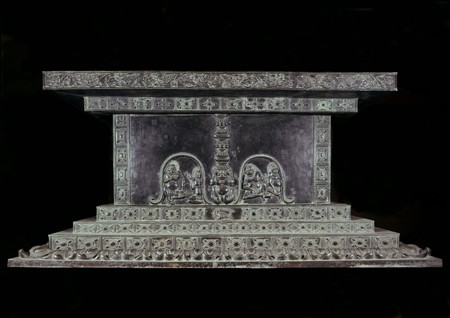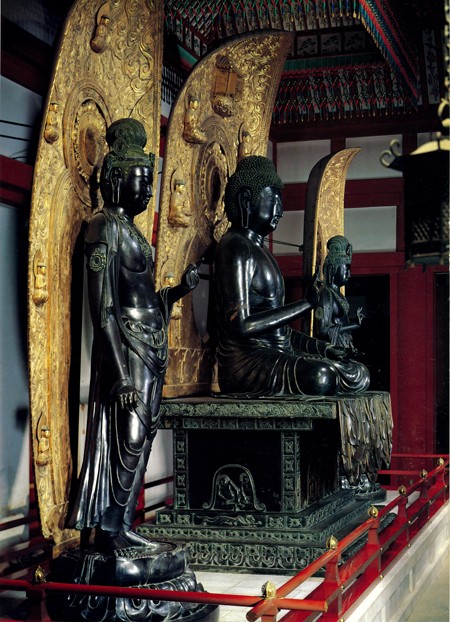During my two-month residency at CASVA I completed an essay asserting that the pedestal is a key piece of evidence in the debates. The vigorous motifs that decorate its four sides are assembled with magical force beneath the seated Buddha. Twelve figures sit in pairs within arched niches, their limbs extending into the viewer’s space, engaging the viewer with enigmatic but communicative gestures and gazes. They are demonic yasha, converts to Buddhism who now carry out the vows of the Yakushi Buddha. On the long sides, composite creatures squat between them supporting pillars on their heads. In the register below the yasha appear the spirit beasts related to the cardinal directions. Along the upper borders of the pedestal, beneath the Buddha, are grapevine arabesques. Geometric motifs complete the decorative program. But is it a program? The absence of any narrative unity for the pedestal figuration, a long history of dead-end searches for visual and scriptural sources in China or Korea, and—most of all—the unprecedented appearance of grapevines and the four spirit beasts on a Buddhist icon have perplexed researchers. In the opinion of the Japanese scholar Itō Shirō, the designs are not unified but are “imported ancient Chinese motifs . . . selected and arranged. . . . [A]lthough the intention is grandiose the comprehension of the expression is immature.”
I argue that the pedestal, for all the attention that its imagery has
received, offers a fresh way of defining the debates. I focus on the very elements that have puzzled scholars and position the figures and motifs in a broad religiopolitical cosmology that demonstrates their connection to Tenmu and Jitō. The unique, so-called non-Buddhist elements are perfectly situated in the worldview and ritual praxis of their rule. The temple’s main icon, Yakushi, rests atop the yasha, once detrimental to Buddhism, now in its service; they allude to foreign threats quelled by Tenmu and Jitō during the period of state formation. The pedestal shape, shumiza, is named for the cosmic center, Mount Sumeru. Imagined as a flattened two-dimensional form, the grapevines around the uppermost border remind us of the backs of ancient Chinese bronze mirrors (widely circulated in Japan) ringed by talismanic symbols, including grape motifs. Such mirror borders typically encircle the magical four-directional spirit beasts, the twelve zodiac animals, or creatures of the sea. My analysis draws on these analogies and others to locate on the pedestal but one cosmology underlying the concept of tennō (heavenly sovereign), an ideology that characterizes Tenmu’s reign and one embodied by the crafting of Tenmu’s predestiny as a unifier of the realm “all under heaven” within the national histories, poetry, and literature of the day. The Nara pedestal under discussion may well be a copy, replete with religiopolitical symbolism, of the base for the main Healing Buddha icon for Tenmu and Jitō’s lost temple in the Fujiwara capital. Or it may be newly conceived with the intention of commemorating the sovereigns.
In a sense, it hardly matters which: the legacy of Tenmu and Jitō is
grounded in acts and representations that were edited, as are all histories, visual or textual, over time. If the eighth-century Nara pedestal copies the late seventh-century pedestal designed under the auspices of Tenmu or Jitō, then it presents the imagery of two rulers’ worldviews. If it is instead newly designed, evoking the rulers’ virtue—as does the only surviving eighth-century inscription at the Nara Yakushiji—then the pedestal participates in the creation of their legacy-in-formation. The same main icon effectively exists in two times and two capitals; my research explores a cosmology that links the pedestal to a history of two sovereigns writ large.

